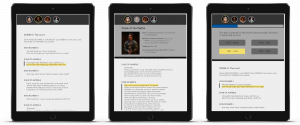Getting in Sync with Shakespeare
We know our audiences like to use their smartphones and tablets (companion devices) while they watch television. Sometimes they use their companion devices to look up things related to what they are watching. For instance: to tell their friends how excited they are about their favourite team’s performance in the world cup or to look up the name of the actor playing the latest Dr. Who’s assistant or to learn more about what a narwhal eats.
What if we could anticipate what our audiences want to do while they watch television and make it possible to do it as simply as possible? What if their companion devices were able interact with their television and figure out what they were watching and where along the programme timeline they were at? If their companion devices knew exactly which scene they were watching on the television, what then? What would they want our companion device to do about it?
Over the past few years, we have worked with colleagues to write up and publish technical standards which will be needed to make this work. We have been building and demonstrating prototypes to showcase the different types of experiences enabled when we allow companion devices to interact with televisions. It was all very cool and interesting work but we really wanted to know if it would add any value to our audiences’ viewing experience.
As part of the 2-IMMERSE project we are focusing on four pilots to build multi-screen experiences of drama and sport. To get the synchronisation across devices right we planned to conduct some user experience studies in the BBC’s user testing labs (pictured below). We wanted to ask members of our audience (potential users) to evaluate a potential companion screen experience.

BBC’s UX testing facilities in London
Christoph Ziegler of IRT came along to work in the BBC’s R&D office in London. As part of the first pilot (an in-home theatre experience) we decided to test the concept of a synchronised script app, on a companion device. This app highlights the line being spoken in parallel to a Shakespearean play, Richard II, being played on a television. The concept was inspired by the use of subtitles in theatres and our conversations with John Wyver of Illuminations Media.

Three versions of the synchronised script app on a companion device
As part of the study, we asked potential users to view a series of short clips of Richard II on a television with a companion device running the synchronised textbook app. While some of the clips are perfectly synchronised to the textbook, others are injected with a pre-determined delay. We are looking to see a) if users notice these injected delays and b) how far users are prepared to tolerate and ‘forgive’ perceived faults in the synchronised experience as a whole.
We also presented users with three variations of the synchronised textbook app. The basic version presented users with a non-interactive textbook in which the relevant line spoken was highlighted in time with the scene on the television. The second version allowed users to click on the actor icons at the top of the app to get more information of the cast involved in the scene. The final version prompted users to take part in a quiz at certain points of the programme. We hope to get an idea of how much interactivity users feel comfortable while watching an engaging theatrical play.
We are also asking users to tell us their thoughts on how well they thought the experience works and what they think of the design of the synchronised textbook app. We showed users alternative versions of the app to see if users thought one design better than the other.
Currently, we are analysing all the feedback users have been kind enough to give us and we hope to have some results to share with you in the near future.
READ MORE‘A great thing’: watching theatre at home since 1939
This post is from John Wyver. John is a writer and media producer. He is a historian of television with a particular interest in broadcasting, film and the arts. He is also responsible for the theatre based prototypes we are developing in 2-Immerse. For more blog posts from John, look here.
John Wyver, 14 August 2016
One evening in early January 1939 the critic Grace Wyndham Goldie sat down before her ‘televisor’ with a question on her mind. As she wrote in The Listener just over a week later she wanted to know whether or not ‘this “straight from the theatre stuff” [was] going to be any good?’ Flickering onto her screen came BBC Television’s outside broadcast from the Phoenix Theatre where Peggy Ashcroft was playing Viola in Twelfth Night. This was only the second occasion on which BBC cameras had ventured out to a theatre to transmit a full-length play; the first had been three months earlier when J.B. Priestley’s comedy When We Are Married had been broadcast to what were perhaps 10,000 sets in and around London. Now, as Wyndham Goldie watched Shakespeare’s comedy of deceit and disguise, ‘the miracle of television came home to me afresh.’ Despite feeling that the experience of seeing the play itself was like ‘watching the action through opera glasses’, it was as if she had been transported to a plush seat in the stalls. ‘There was the actual feeling of being in a theatre. There was the view of the stage and the buzz of conversation and the orchestra tuning up and the curtain rising… Now this is a great thing.’
For nearly eighty years, television has sought to achieve this ‘great thing’ of putting across ‘the actual feeling of being in a theatre’. Before the Second World War there were further broadcasts from the West End, including of the musical Me and My Girl with its hit song ‘The Lambeth Walk’ (and three minutes of precious footage from this survive in the archive). When the television service resumed after the war, West End theatre managers were less keen to have their shows broadcast by an upstart medium that was increasingly viewed as unwelcome competition. Until, that is, Brian Rix’s farces from the Whitehall Theatre demonstrated how effective television could be at selling tickets for stage shows. In the 1950s television broadcast live from the Shakespeare Memorial Theatre in Stratford-upon-Avon and from the Royal Court, screening a substantial extract of the ground-breaking 1956 production of John Osborne’s Look Back in Anger (although frustratingly this was not recorded). Productions from the Old Vic and the National Theatre followed, as well as stagings by companies in Bristol, Birmingham and beyond. Increasingly, however, television drama came to mean not theatre relays but original plays and series written by the likes of David Mercer and Dennis Potter for production in the studio. But an interest remained in showing the stage on screen, whether that was the Royal Shakespeare Company’s epic Nicholas Nickleby, recorded at the Old Vic, or a production of Richard II, shown live from Shakespeare’s Globe in 2003. Last Christmas, BBC Four demonstrated how potent the idea remains when it offered a recorded version of Gypsy! from the Savoy Theatre. Then in 2009 NT Live started theatre broadcasts in cinemas with a presentation of Phèdre. This inaugurated a rapidly developing and much-loved form that has been picked up by the RSC, Kenneth Branagh Theatre Company and, most recently, the Almeida Theatre with Richard III. As anyone who has been to an ‘event cinema’ screening of this kind will recognise, they create ‘the actual feeling of being in a theatre’ in part by assembling around you an audience which shares the drama and the comedy – and often the applause.
Responding both to theatre on television and in cinemas, one of the key aims of the 2-Immerse watching theatre at home trial is to create that social sense of watching with an audience even as, seated on your sofa, you have ‘the actual feeling of being in a theatre’. So for our first prototype we are exploring how best to enhance a broadcast screening with sharing and responding and chatting with others who are watching at the same time. The long tradition of watching theatre at home suggests that there is an interested and eager audience, and what we hope we can do is ensure that ‘this “straight from the theatre stuff”’ can be even better and richer and more interesting than Grace Wyndham Goldie found Twelfth Night back in 1939.
READ MORE

